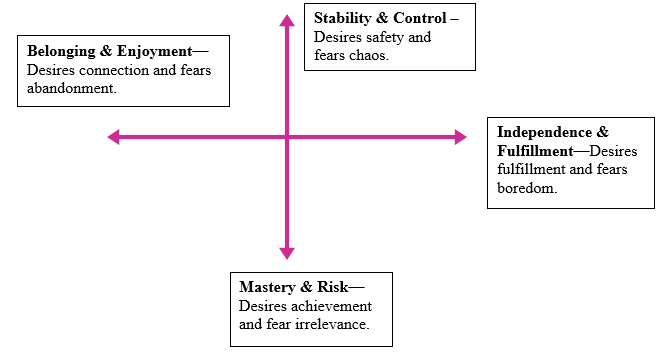What does Victoria’s Secret have in common with Habitat for Humanity? On the surface they may seem unrelated, but these brands share the same unconscious goals. Beyond their product, Victoria’s Secret help their customers nurture relationships. Similarly, Habitat for Humanity homebuilders are driven to create a space for families to connect. Despite their vastly different operations, the two organizations share the same core desire: to facilitate intimacy and love. In short, they are The Lover brand archetype. Conceptualized as a system for brands to “manage meaning,” the Brand Archetype Framework uses universally known characters (known as archetypes) to define and outline the internal motivations of a company or brand.
Companies that successfully define and integrate brand archetypes into their business strategy tap into a universal system of symbols that effectively and efficiently communicate a brand’s values internally, so they can be conveyed externally.
Our team regularly applies this framework and has incorporated it into the foundation of our brand strategy work. By starting with an archetypal framework, the brand strategy establishes a shared language and understanding from the outset, ensuring all stakeholders have bought into the brand’s essential purpose. As marketers work to externalize the brand’s personality, non-marketers can better communicate and provide insight by relating content back to the archetype.
Meet The Framework
Theorized by Margaret Mark and Carol S. Pearson in their book The Hero and The Outlaw, brand archetypes are characterized by internal motivations rather than external behaviors. Simply put, a brand archetype articulates a company’s essence, rather than describing its outward appearance. In doing so, archetypes inscribe meaning into the products and brands.
Based on motivational theory, brand archetypes are organized across two axes: Independence/Belonging and Stability/Mastery. As result, these poles reveal four distinct categories of archetypes defined by core desires.

Within these four quadrants are three archetypes, each with distinct traits. Although a description of each archetype is beyond the scope of this blog, the sight of their names alone should already call to mind common traits.
Common Mistakes When Using Brand Archetypes
Brand managers, proceed with caution. Before running to label a brand as a certain archetype, it’s crucial to understand what a brand archetype isn’t.
Archetypes describe your brand, not your customers.
Gone are the days of “know thy customer, know thyself.” Often, we can conflate our customer profile with brand. But take a step back. Like characters in a book, the archetype defines the role a brand plays in its customers’ story. If a brand and customer were the same archetype, why would they need one another?
When Indiana Jones sets out on an adventure, he doesn’t bring another Indiana Jones with him. Instead, he balances his Explorer weaknesses with the strengths of others. He might seek the wisdom of a Sage or power of a Magician to assist him on his journey. Similarly, brands can fulfill the same gaps for customers. Suburban Starbucks patrons “escape” when they treat themselves to a freshly roasted exotic blend from the Explorer brand.
Archetypes are discovered, not created
A framework strategically organizes information for a specific use. By that definition, archetypes are a way for companies to consolidate their brand “biography” into a singular title and all it symbolizes. Because brand archetypes are governed by unconscious motivation, it’s nearly impossible for companies to consciously change their archetypes. The most effective archetypal brands are the ones that are authentically aligning their actions and words with who they really are. This alone creates trust with customers (even for Outlaw brand archetypes).
The discovery phase can (and should) be time intensive. This is the time to make Carl Jung proud and psychoanalyze your business to create a biographical sketch of the brand. At Zion & Zion, we use workshops and interviews to facilitate these conversations and serve as an outside perspective. This guided investigation of the brand helps to align stakeholders on the answers to critical questions about the brand:
- Who created this brand? When? Why?
- How have customers related to the brand in the past? How do they relate to it now?
- Where does the brand fit into the customer’s life? Where does it not?
Framing Your Archetype as a North Star
Once you’ve identified your archetype, the real magic starts. In a single word, anyone in the organization can conceptualize a brand’s complexities and role in the customer’s story. Pearson and Mark describe archetypes as the North Star for a brand: “an enduring and reliable compass–a fixed place that illuminates both where they are and where they must go.” (Heroes and outlaws, 11). Archetypes outline the soul of the brand, adding purpose and emotionality to already existing business activities.
Brand managers can use this to simplify their message internally to help their team communicate externally. At Zion & Zion, the archetype framework helps us organize and manage multiple brands. Serving as a guiding light, a brand archetype allows anyone to ask, “would my brand do that?” As brands integrate an archetype into their strategy there are a few practices to inspire adoption.
Make it Part of The Vernacular –
Archetypes create a shared language for discussing complex and nuanced topics. In the creative process, a defined brand archetype can be useful in evaluating messaging and communicating feedback. “Can this headline be more aligned with the Outlaw?” “What media outlets would the Innocent fit with?”
Many Faces, One Archetype
“I contain multitudes” and so do archetypes. Although a brand archetype doesn’t change, the brand’s identity will always be evolving. With an archetype serving as a North Star, businesses can experiment and expand more authentically.
Show, Don’t Tell
Brand archetypes are only as strong as the business activities that keep them alive. The most prevalent archetypal brands make business decisions aligned to their archetypal purpose. Beyond sales and marketing, archetypes can guide financial and operational decisions to be in alignment with the brand.
Bringing Purpose to Marketing
As marketers, we’re trained to put ourselves into the customers’ shoes, separating our personal tastes from our professional work. However, this distance also inhibits marketers from tapping into the unconscious traits that connect the marketer to the brand and to the customer, and to the company itself. By digging deep into questions of purpose and motivation, we bring awareness to the unconscious traits and discover the unconscious connections that were there all along.
Archetypes fill this gap. Marketers who struggle to relate to their product can find meaning in its archetype and its purpose. The better marketers can relate to the product and message, the more effective they can advocate for the brand’s needs across an organization.
